Kaiser Health Tracking Poll: November 2015
Kaiser Health Tracking Poll: November 2015 Findings
As the problem of prescription painkiller abuse has captured greater attention from policymakers and the media, the November Kaiser Health Tracking Poll explores the public’s connection to and knowledge of the issue, as well as their views of how to address it. A surprising 56 percent of the public say they have some personal connection to the issue – either because they say they know someone who has taken a prescription painkiller that wasn’t prescribed to them, know someone who has been addicted, or know someone who has died from a prescription painkiller overdose. More of the public says it’s easy for people to get access to painkillers not prescribed to them than say it is easy for people who medically need them to access them (77 percent vs.58 percent). Combatting the problem of opioid abuse ranks among several other priorities the public has for their state officials, with 50 percent saying it should be a top priority, lower than the shares who say other issues such as improving public education (76 percent) or attracting and retaining business and jobs (64 percent) are top priorities, but similar to the shares who place a top priority on reforming the criminal justice system (50 percent) and improving infrastructure (46 percent). The public is largely supportive of ‘Good Samaritan’ laws that some states have adopted that allow people to call for emergency medical help for a drug overdose for themselves or others without fear of being prosecuted (63 percent). However, when it comes to views on access to Naloxone, a medication that can reverse the effects of a drug overdose, most of the public believes that access should be restricted to those with a prescription (62 percent). Large majorities say a number of efforts would be effective in reducing painkiller abuse, including treatment programs (85 percent), monitoring doctors’ prescribing habits (82 percent), public education programs (80 percent), training doctors (79 percent), and encouraging people to appropriately dispose of leftover medication (69 percent).
While views of the health care law have been narrowly divided for much of the year, this month more say they have an unfavorable view of the law than a favorable one (45 percent versus 38 percent, a statistically significant difference). About a third of the public (35 percent), including 40 percent of the uninsured, says they are closely following news coverage of the ACA’s third open enrollment period. The uninsured report valuing insurance, with large majorities saying it is personally important to have (86 percent) and that it is something they need (69 percent), and just over half (55 percent) intend on getting coverage in the next few months. When asked to say in their own words why they are uninsured, the most common response is that insurance is too expensive and they can’t afford it (33 percent).
Prescription Painkiller Abuse
The abuse of prescription painkillers is receiving more attention and President Obama recently addressed the issue, calling for more federal action to prevent and treat addiction. This month’s Kaiser Health Tracking Poll takes a look at the issue, examining the public’s personal connection to and knowledge of the issue as well as their views of what approaches may be effective in reducing the abuse of prescription painkillers.
Widespread Personal Connections to the Issue
More than half (56 percent) of the public report that they have some personal connection to the issue, saying that they or someone they know has abused, been addicted to, or died from prescription painkillers. More specifically, nearly half (45 percent) say they personally know someone who has taken a prescription painkiller that was not prescribed to them, including 6 percent who say they personally have done this and an additional 27 percent who say that a close friend or family member has. About four in 10 (39 percent) say they know someone who has been addicted to prescription painkillers, including 2 percent who say they personally have been and an additional 25 percent who say a close friend or family member has been addicted. About 1 in 6 (16 percent) say they know someone who has died from a prescription painkiller overdose, including 9 percent who say that person was a family member or close friend.
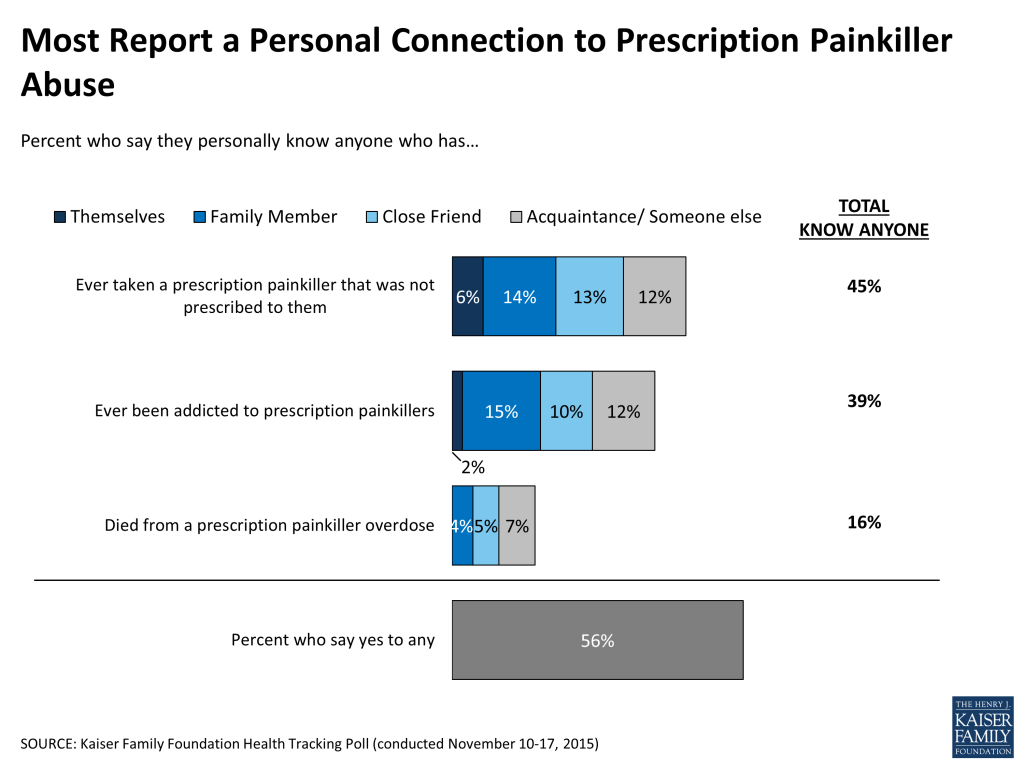
Exposure to prescription painkiller abuse, addiction and overdose impacts some subsets of the U.S. population more than others. For instance, whites are more likely than Blacks and Hispanics to say to have a personal connection to prescription painkillers (63 percent vs. 44 percent and 37 percent, respectively). Additionally, young and middle-aged Americans are more likely than adults ages 65 and older to report a personal connection to prescription painkillers. Otherwise, across most demographic groups, majorities report having a personal connection to the issue.
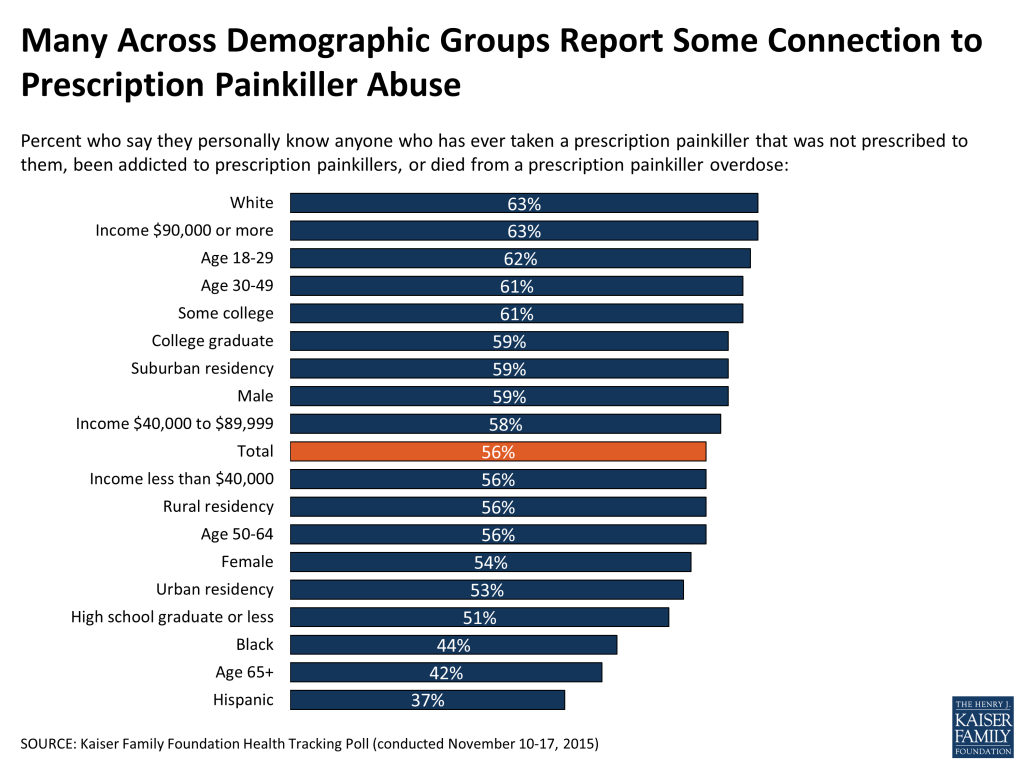
Knowledge of Epidemic
Drug overdose ranks as the leading cause of accidental deaths in the U.S. according to the Centers for Disease Control and Prevention,1 yet 4 in 10 (40 percent) Americans are aware of this fact. A larger share instead names car accidents as the main culprit (50 percent), 6 percent say falls, and the rest are unsure or volunteer another cause. Those who say they know someone who has died of a prescription painkiller overdose are more likely than those who say they don’t to correctly respond that the leading cause of accidental deaths in the U.S. is drug overdose (50 percent vs. 38 percent).
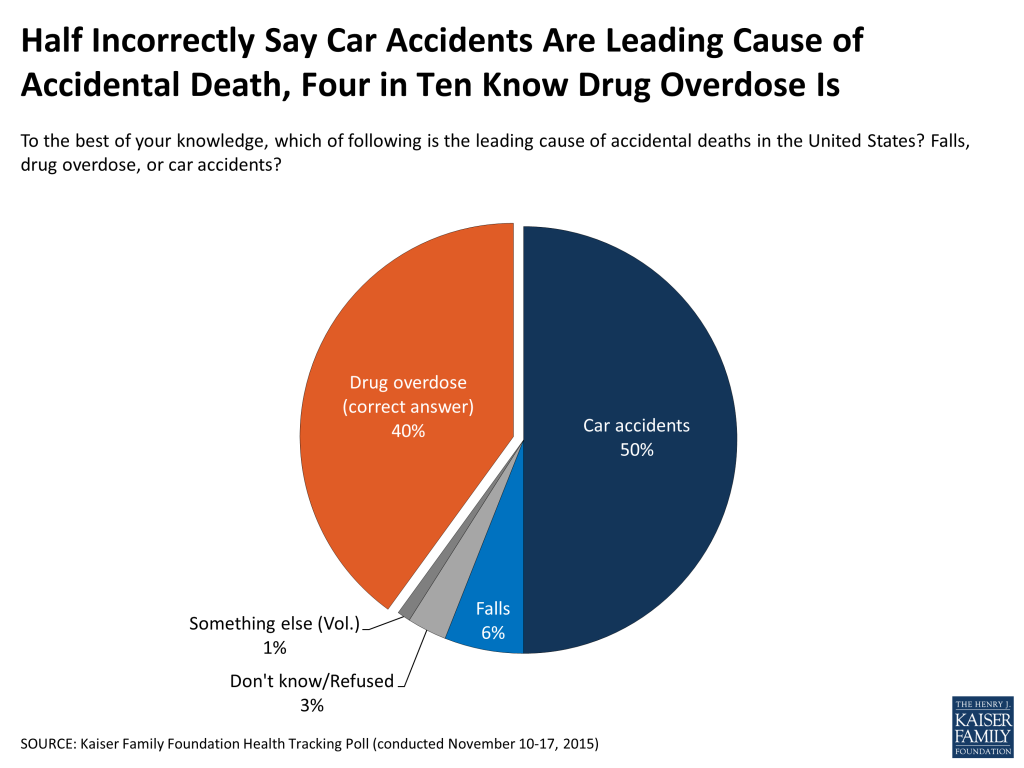
Access to Prescription Pain Medicines
In the debate about how to rein in the abuse of prescription drugs, policymakers and medical professionals are faced with finding an appropriate balance so that access to these drugs is restricted for those who are abusing them, while at the same time, maintaining access for those who medically need them. The perception among the public is that the balance is currently in the abuser’s favor. More of the public says it’s easy for people to get access to painkillers not prescribed to them than say it is easy for people who medically need them to access them (77 percent vs.58 percent). In fact, about 4 in 10 (39 percent) say they think it is difficult for those who medically need prescription painkillers to access them.
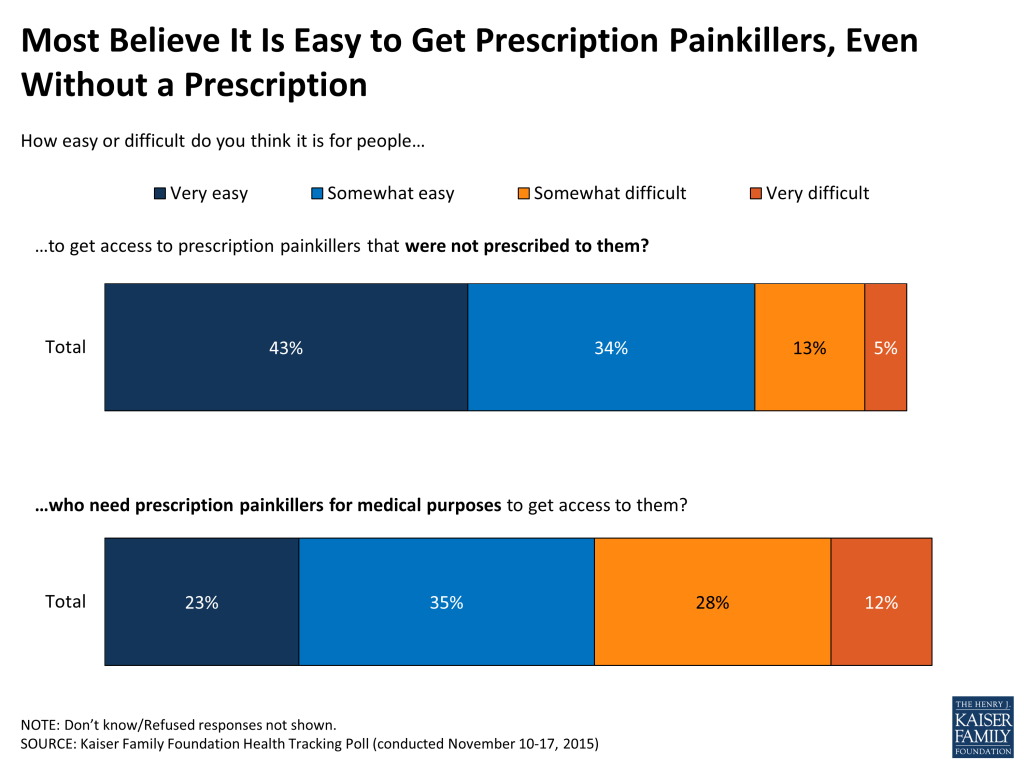
Views and Knowledge of Prescription Painkillers Compared to Heroin
There are some misconceptions about how similar or different prescription painkillers are from heroin. In terms of how they affect the user’s body, just over half (54 percent) of the public correctly say heroin and prescription painkillers are similar, but a third (33 percent) say they affect the body differently, and 13 percent say they don’t know. When asked which is more risky to use, about half (51 percent) of the public says they are about equally risky, while about four in ten (42 percent) hold the view that heroin is more risky. Few (5 percent) say that it’s more risky to use prescription painkillers than heroin. In addition, most of the public (55 percent) acknowledges that abusing prescription painkillers makes a person more likely to use heroin or other illegal drugs,2 while about a third (35 percent) say it doesn’t make much of a difference and few (4 percent) believe prescription drug abuse makes someone less likely to use other illegal drugs.
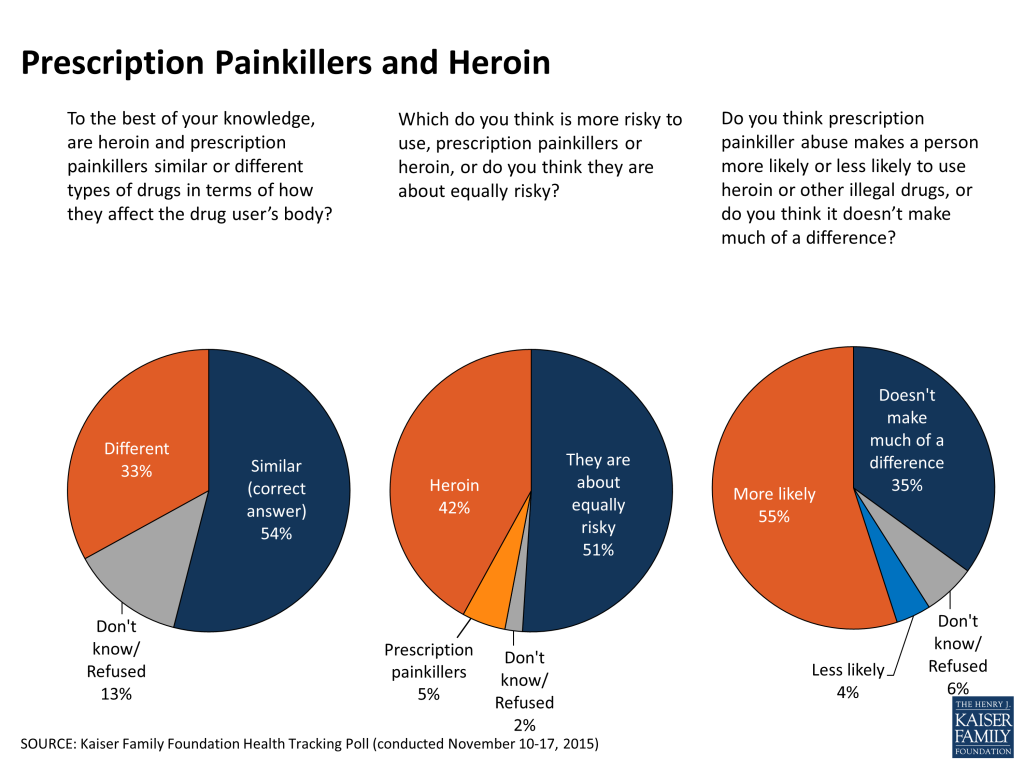
Combatting the Problem
Combatting the abuse of prescription painkillers and heroin is one of many priorities the public would like their state governor and legislature to address. Half (50 percent) say reducing the number of people abusing prescription painkillers or heroin should be a top priority for their state lawmakers. This ranks below a number of other issues the public sees as top priorities for their state such as improving public education (76 percent), making health care more accessible and affordable (68 percent), attracting and retaining businesses and jobs (64 percent), and reducing crime (64 percent). Reducing opioid abuse ranks among other issues such as protecting the environment (54 percent), reforming the criminal justice system (50 percent) and improving infrastructure, like buildings and roads (46 percent). Among those who say they know someone who has died of a drug overdose, 65 percent say reducing the number of people abusing prescription painkillers or heroin should be a top priority.
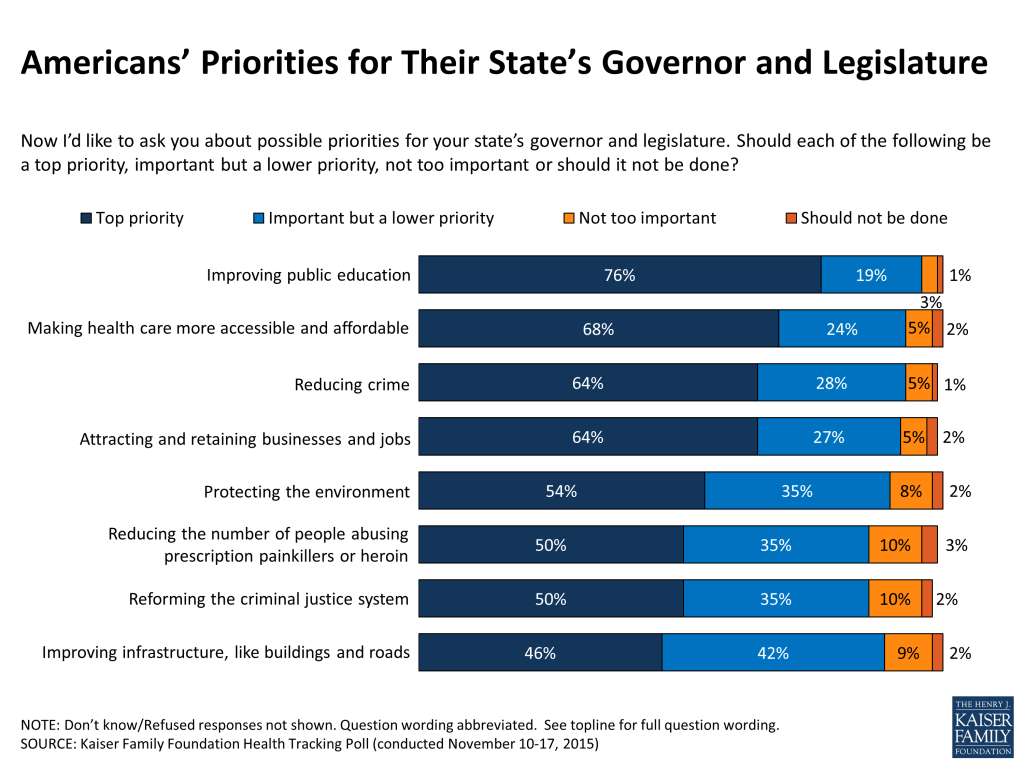
The public is divided about which level of government should be primarily responsible for combatting prescription painkiller abuse, with about equal shares saying it is the responsibility of the federal government (36 percent) or the state government (39 percent). An additional 16 percent say the responsibility should fall to local governments. Republicans are more likely to say the responsibility primarily falls to state governments rather than the federal government (57 percent vs. 22 percent), while Democrats are more apt to say it falls to the federal government rather than state governments (47 percent vs. 29 percent).
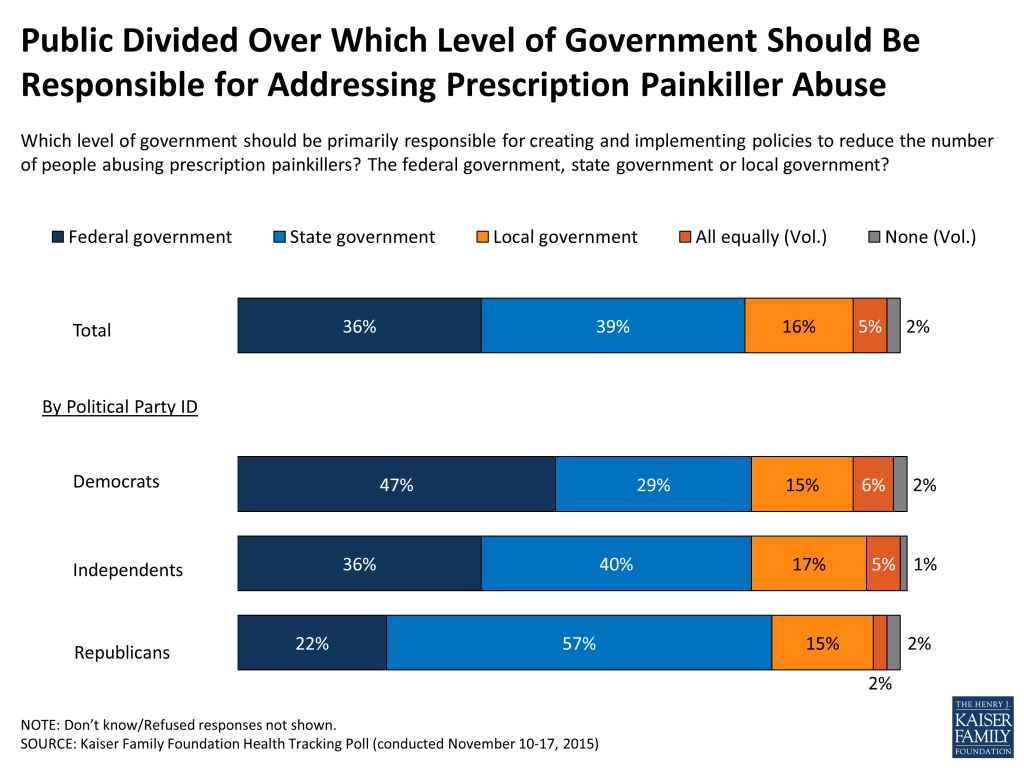
Some states have passed laws specifically aimed at lowering the number of deaths from opioid overdoses.3 One such law is related to a drug called Narcan or Naloxone that can prevent people from dying if they are experiencing an overdose of a prescription painkiller or heroin. Some states have passed laws to make this drug available to adults without a prescription while other states restrict the sale of the drug due to concerns it might encourage the use of illegal drugs. When asked their views on these laws, most of the public (62 percent) say access to the drug should only be allowed with a prescription, nearly twice the share who say it should be available without a prescription (33 percent). Republicans (74 percent) are more likely than Democrats and independents to say access to the drug should be restricted, but still majorities of Democrats (54 percent) and independents (61 percent) agree. Those who know someone who has abused prescription painkillers or died from an overdose are more likely than those who don’t to say people should be able to get the drug without a prescription (41 percent vs. 23 percent).

Another approach some states have taken to reduce opioid deaths is enacting ‘Good Samaritan’ laws, whereby people who call for emergency medical help for a drug overdose for themselves or others are not arrested for having or using the illicit drug. However, some criticize this approach saying it is too lenient on drug users. Most of the public (63 percent), including majorities across party lines, say these types of laws are a good idea, while 3 in 10 (30 percent) say they are a bad idea. Those who say they have a personal connection to the issue are more likely than others to say ‘Good Samaritan’ laws are a good idea (67 percent vs. 58 percent).
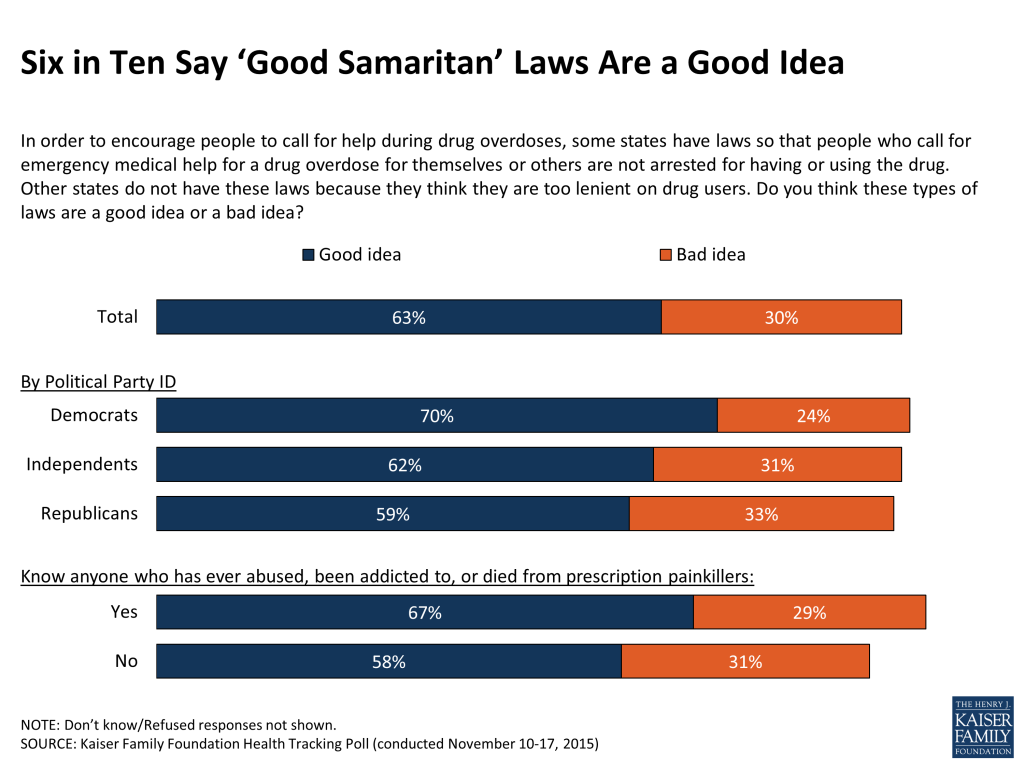
Large majorities of the public say a number of other efforts to reduce prescription painkiller abuse would be at least somewhat effective, such as providing treatment for those who are addicted to prescription painkillers (85 percent), monitoring doctors’ prescription painkiller prescribing habits (82 percent), public education and awareness programs (80 percent), training doctors on the appropriate use of prescription painkillers (79 percent), and encouraging people who were prescribed painkillers to dispose of any extras once they no longer medically need them (69 percent).
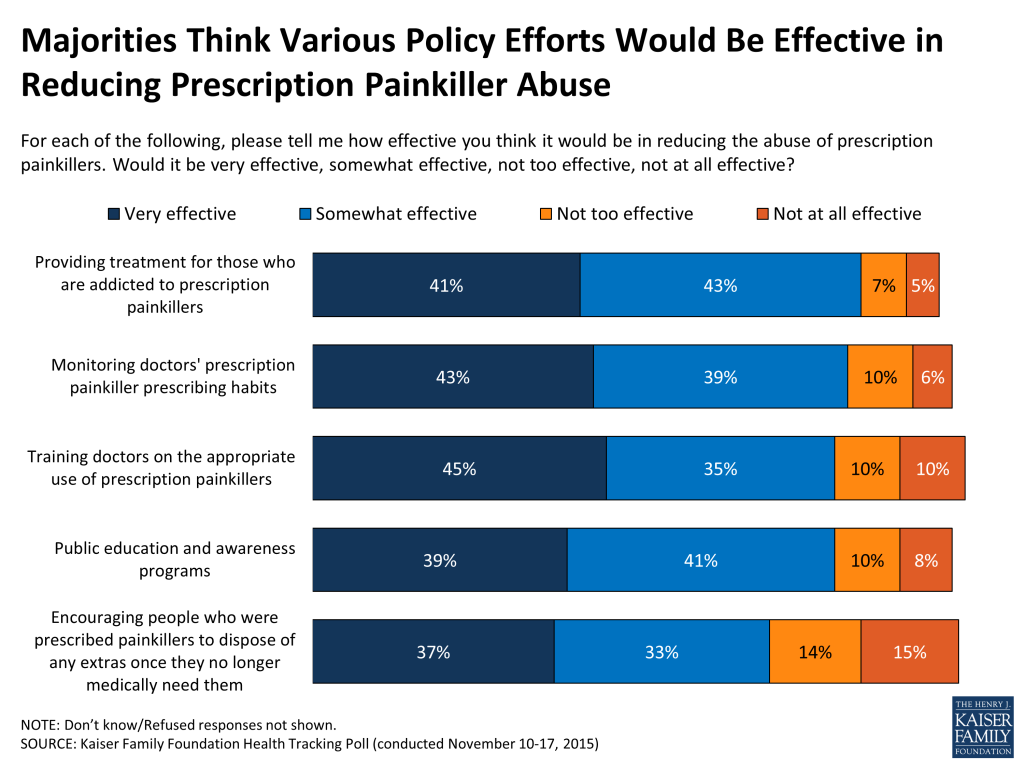
Views of the ACA
While views of the health care law have been narrowly divided for much of the year, this month, more say they have an unfavorable view of the law than a favorable one (45 percent versus 38 percent, a statistically significant difference). As has been true since the law passed, there is a stark partisan divide on views of the law. A majority of Democrats (63 percent) report a favorable opinion and a majority of Republicans (75 percent) report an unfavorable one. Independents fall in the middle with 36 percent feeling favorable and 44 percent feeling unfavorable.
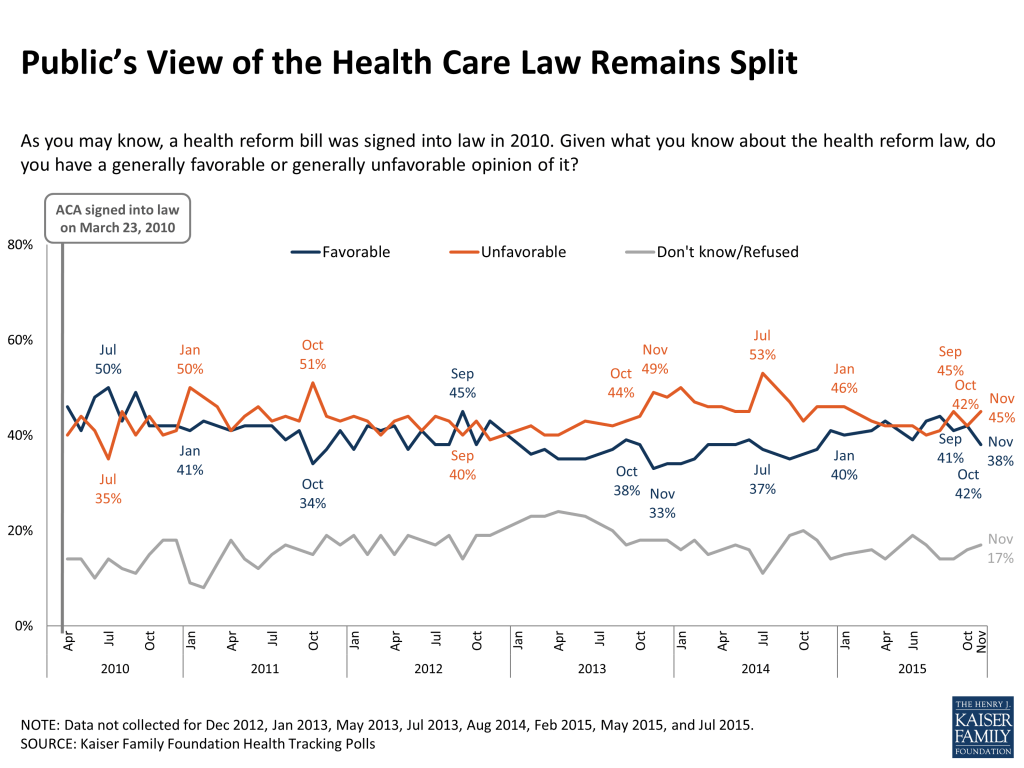
In line with findings from previous Kaiser Health Tracking Polls, the public doesn’t agree on what Congress should do when it comes to the health care law. Three in 10 (30 percent) say they would like Congress to repeal the entire law and 12 percent want Congress to scale back what the law does, while 16 percent think it is best to move forward with implementing the law as is and 26 percent say they would like to see Congress expand what the law does. Similar to overall opinion of the law, opinions about the future of the law vary starkly by political party identification.
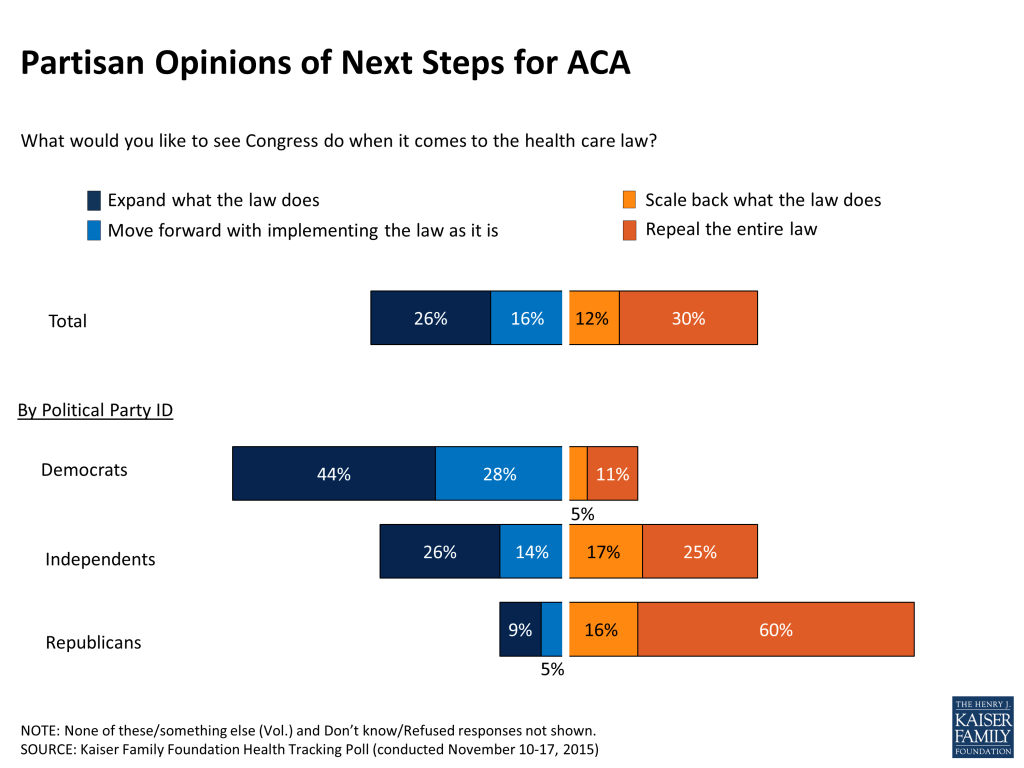
Kaiser Health Policy News Index: November 2015
The Kaiser Health Policy News Index is designed to help journalists and policymakers understand which health policy-related news stories Americans are paying attention to, and what the public understands about health policy issues covered in the news.
Health policy news took a back seat to other national and international news stories this month, as the public’s attention was focused on news coverage of the 2016 presidential campaigns and international conflicts involving ISIS and other Islamic militant groups in Iraq and Syria (about three-quarters say they followed each story ‘very’ or ‘fairly’ closely). This survey was in the field during the attacks on Paris, and those who took the survey on or after the day of the attacks are slightly more likely to say they followed news about ISIS (77 percent), but still 69 percent of those who took the survey before the attacks say they followed this news. Roughly half of the public reports closely following the crash of a Russian Metrojet airplane in Egypt (55 percent) and the controversy about government funding for Planned Parenthood (56 percent), along with other national stories such as discussions in Washington about the federal budget (50 percent) and news that Paul Ryan was appointed as the new Speaker of the House of Representatives (45 percent). Fewer than 4 in 10 say they closely followed damage in Mexico caused by Hurricane Patricia (37 percent) and the health policy stories about the release of 2016 health insurance premium rates (36 percent) and the health care law’s third open enrollment period (35 percent).
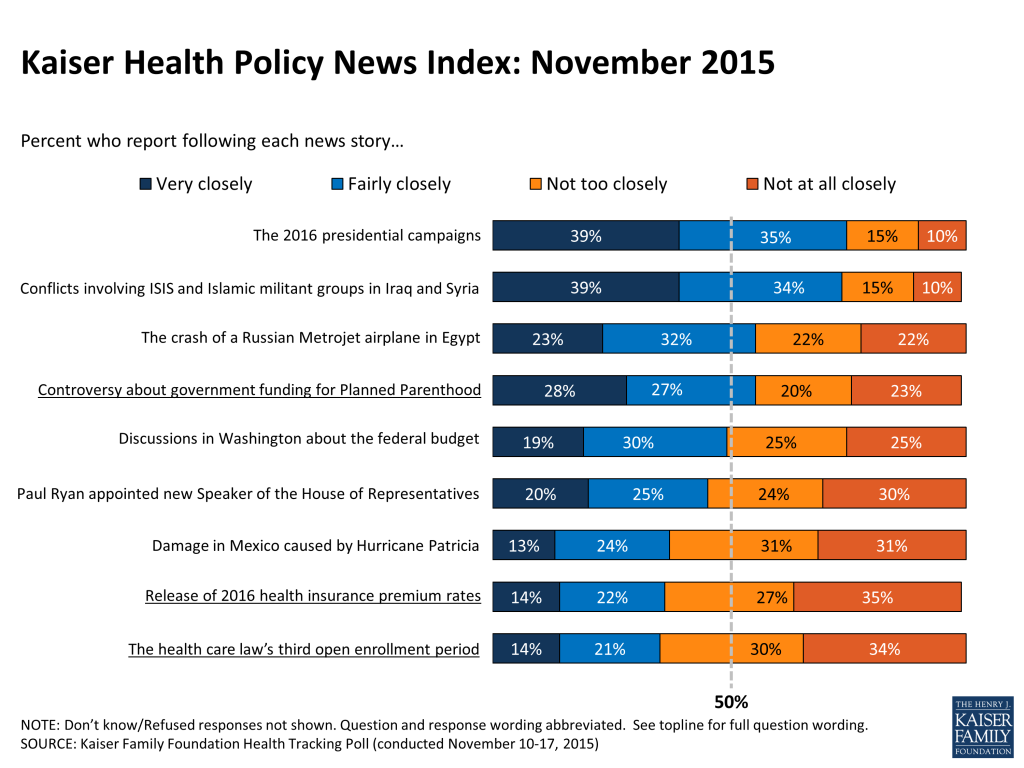
The ACA’s Third Open Enrollment Period and the Uninsured
This month marks the start of the third open enrollment period under the health care law, which provides the opportunity to purchase health insurance on the exchanges and access to financial assistance, and the uninsured remain a key target for enrollment efforts. While 4 in 10 uninsured Americans (40 percent) report closely following news coverage of the health care law’s third open enrollment period, most say they value health insurance. Seven in 10 (69 percent) of the uninsured say health insurance is something they need, while 3 in 10 (29 percent) say they are healthy enough to go without. Additionally, the vast majority of the uninsured (86 percent) say it is at least somewhat important to them personally to have health insurance, including about 6 in 10 (63 percent) who say it is very important.
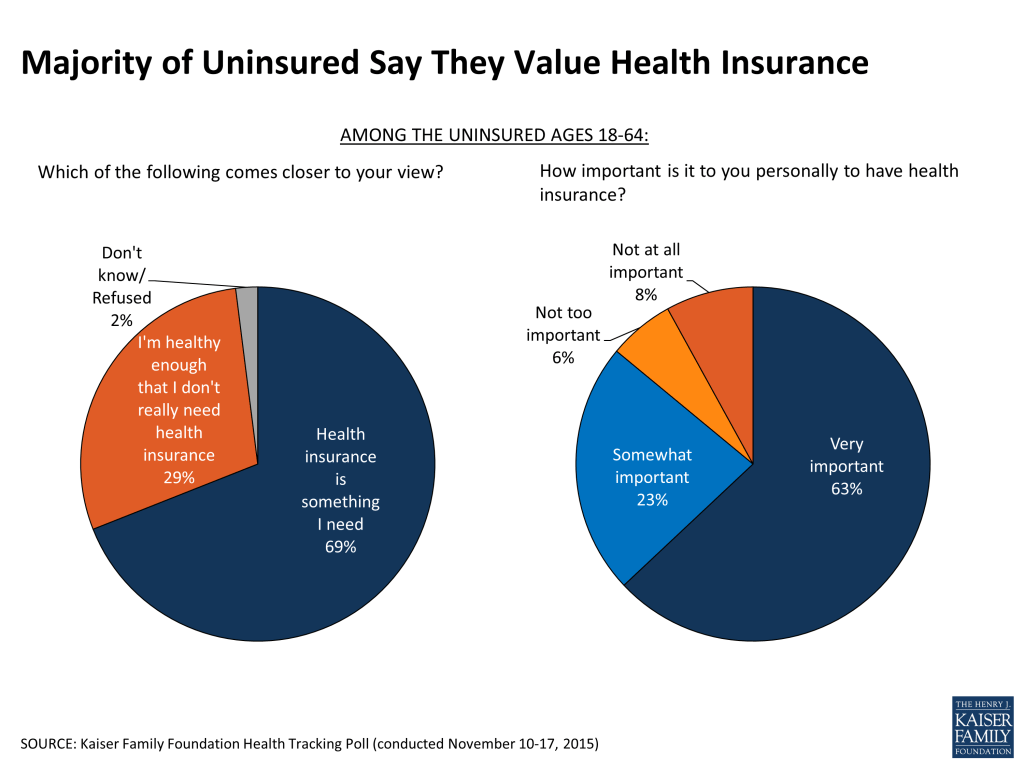
While a majority of the uninsured (68 percent) say they have not tried to get insurance in the past 6 months, about a third (32 percent) say they have tried but remain uninsured. When the uninsured are asked about the main reason they don’t have coverage, the most common response is that insurance is too expensive and they can’t afford it (33 percent), followed by job-related issues such as unemployment or their employer doesn’t offer health insurance (22 percent). About one in ten each say they don’t need or want health insurance (10 percent), or that citizenship or residency issues have prevented them from getting it (9 percent). Just over half (55 percent) say they plan to get health insurance in the next few months, while four in ten (40 percent) expect to remain uninsured.
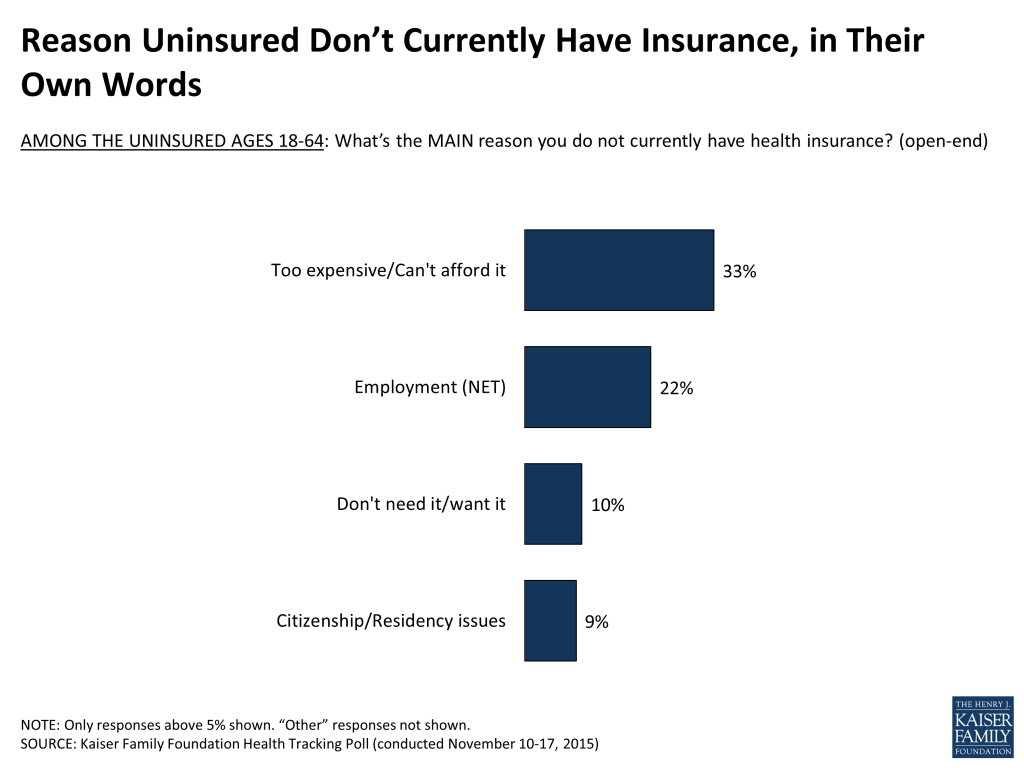
Kaiser Health Tracking Poll: November 2015 Methodology
This Kaiser Health Tracking Poll was designed and analyzed by public opinion researchers at the Kaiser Family Foundation (KFF). The survey was conducted November 10-17, 2015, among a nationally representative random digit dial telephone sample of 1,352 adults ages 18 and older, living in the United States, including Alaska and Hawaii (note: persons without a telephone could not be included in the random selection process). Computer-assisted telephone interviews conducted by landline (540) and cell phone (812, including 476 who had no landline telephone) were carried out in English and Spanish by Princeton Data Source under the direction of Princeton Survey Research Associates International (PSRAI). Both the random digit dial landline and cell phone samples were provided by Survey Sampling International, LLC. For the landline sample, respondents were selected by asking for the youngest adult male or female currently at home based on a random rotation. If no one of that gender was available, interviewers asked to speak with the youngest adult of the opposite gender. For the cell phone sample, interviews were conducted with the adult who answered the phone. KFF paid for all costs associated with the survey.
The combined landline and cell phone sample was weighted to balance the sample demographics to match estimates for the national population using data from the Census Bureau’s 2013 American Community Survey (ACS) on sex, age, education, race, Hispanic origin, nativity (for Hispanics only), and region along with data from the 2010 Census on population density. The sample was also weighted to match current patterns of telephone use using data from the July-December 2014 National Health Interview Survey. The weight takes into account the fact that respondents with both a landline and cell phone have a higher probability of selection in the combined sample and also adjusts for the household size for the landline sample. All statistical tests of significance account for the effect of weighting.
The margin of sampling error including the design effect for the full sample is plus or minus 3 percentage points. Numbers of respondents and margins of sampling error for key subgroups are shown in the table below. For results based on other subgroups, the margin of sampling error may be higher. Sample sizes and margins of sampling error for other subgroups are available by request. Note that sampling error is only one of many potential sources of error in this or any other public opinion poll. Kaiser Family Foundation public opinion and survey research is a charter member of the Transparency Initiative of the American Association for Public Opinion Research.
| Group | N (unweighted) | M.O.S.E. |
| Total | 1,352 | ±3 percentage points |
| Party Identification | ||
| Democrats | 425 | ±6 percentage points |
| Republicans | 372 | ±6 percentage points |
| Independents | 390 | ±6 percentage points |
| Insurance Status | ||
| Insured, ages 18-64 | 838 | ±4 percentage points |
| Uninsured, ages 18-64 | 112 | ±10 percentage points |
| Know anyone who has abused, been addicted to, or died from prescription painkillers | ||
| Yes | 760 | ±4 percentage points |
| No | 577 | ±5 percentage points |
Endnotes
- The Centers for Disease Control and Prevention, Accidents or Unintentional Injuries, http://www.cdc.gov/nchs/fastats/accidental-injury.htm ↩︎
- The Centers for Disease Control and Prevention, New research reveals the trends and risk factors behind America’s growing heroin epidemic, http://www.cdc.gov/media/releases/2015/p0707-heroin-epidemic.html ↩︎
- National Conference of State Legislatures, http://www.ncsl.org/research/civil-and-criminal-justice/drug-overdose-immunity-good-samaritan-laws.aspx ↩︎